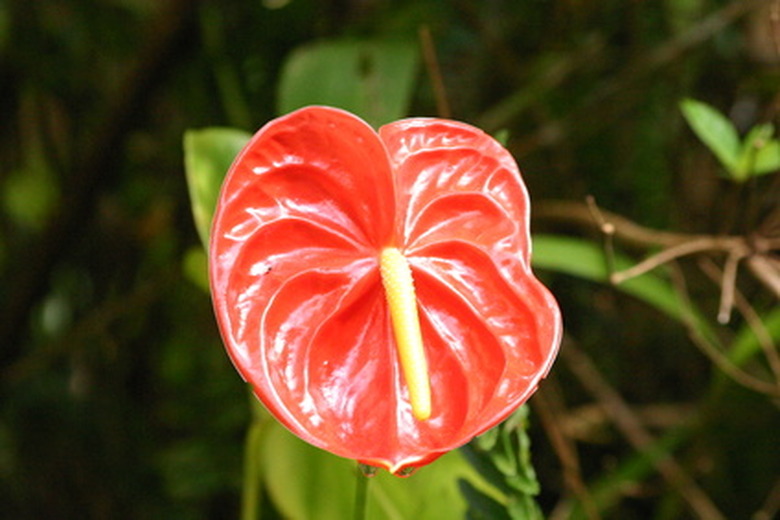Hawaiian Tropical House Plants
Because tropical house plants thrive in Hawaii's warm, humid climate, many species are cultivated commercially for export. Some of these plants, such as orchids, have been grown by Hawaiian nurseries for so long that many people think of them as Hawaiian, even though they are not native to the islands. Most house plants grown in Hawaii for export are generally hardy and easily grown indoors.
Flowering Plants
Anthuriums (Anthurium x ferrierense), also called flamingo flowers, are tropical evergreen plants native to the rain forests of Columbia and Ecuador. They were brought to the Hawaiian Islands in 1889, and since then horticulturalists have developed hundreds of cultivars. Anthurium culture for cut flowers and nursery plants is a multimiliion dollar industry in Hawaii today. These exotic houseplants have large, leathery, heart-shaped leaves and grow from 2 to 3 feet high. They produce long-lasting, waxy, heart-shaped flowers in red, orange, pink, white and green. Anthuriums require high humidity, warmth, filtered light and moist, very well-drained soil. In pot culture, they benefit from daily misting with a spray bottle and a humidity tray.
- Because tropical house plants thrive in Hawaii's warm, humid climate, many species are cultivated commercially for export.
- Some of these plants, such as orchids, have been grown by Hawaiian nurseries for so long that many people think of them as Hawaiian, even though they are not native to the islands.
Dendrobium orchids (Dendrobium spp.) are widely grown in Hawaii for cut flowers, lei material and house plants. Botanists recognize two types: deciduous and evergreen. Hawaiian breeders have developed many evergreen type cultivars, with flower colors including white, pink, red, purple and nearly blue. Two common species, D. phalaenopsis and D. bigibbum, grow indoors relatively easily. Both species require a well-drained medium, regular moisture and filtered light. Spray dendrobiums every two weeks with liquid foliar orchid food.
- Dendrobium orchids (Dendrobium spp.)
- Two common species, D. phalaenopsis and D. bigibbum, grow indoors relatively easily.
Foliage Plants
The green ti plant (Cordline fruitcosa) is a familiar sight at luaus, where it is used for decoration, leis and food wrapping. These large-leaved plants were brought to Hawaii by the early Polynesians and have cultural and religious significance to traditional Hawaiians. Ti grows equally well in the landscape and in pot culture. It requires rich, moist soil and partial sun. A related species known as red ti (Cordyline terminalis) bears colorful leaves in many combinations of red, pink and orange.
Dracaenas (Dracaena spp.) are tree-like shrubs native to Africa which bear pompoms of blade-shaped leaves on the ends of sinuous woody stems. About 20 species of dracaena are grown commercially in Hawaii, mostly for export as interior plants. These tough plants can survive low light, drought and small pots, which makes them excellent candidates for indoor culture. Dracaenas do best in partial shade areas with well-drained soil and moderate moisture.
- The green ti plant (Cordline fruitcosa) is a familiar sight at luaus, where it is used for decoration, leis and food wrapping.
- These tough plants can survive low light, drought and small pots, which makes them excellent candidates for indoor culture.
Palms
The lady palm (Rhapis excelsa) is a small, clustering palm native to China. It grows up to 15 feet tall and has deep green, five-lobed leaves and bamboo-like stems. These versatile palms are commonly grown in Hawaii for export as interior plants. They require partial shade, moist soil and monthly applications of a balanced liquid fertilizer.
The parlor palm (Chamaedorea elegans) is another widely grown palm in Hawaii for use in the interior scape. It grows to 6 feet high on a solitary trunk but is often sold with several palms to one pot, giving the appearance of a clumping habit. This palm bears long, fringed fronds, and resembles a miniature coconut palm. Parlor palms grow best in partial shade with rich, moist soil but will tolerate full shade.
- The lady palm (Rhapis excelsa) is a small, clustering palm native to China.
- The parlor palm (Chamaedorea elegans) is another widely grown palm in Hawaii for use in the interior scape.
References
- University of Hawaii: CTAHR: Information on Tropical Crop Production in Hawaii
- "A Tropical Garden Flora"; George Staples and Derral Herbst; 2005
